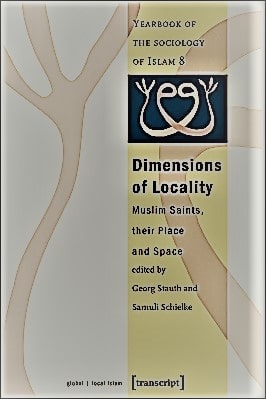
| Book Title | Dimensions Of Locality |
| Book Author | Georg Stauth |
| Total Pages | 256 |
| Book Views | |
| Language | English |
| Book Download | PDF Direct Download Link |
| Get Hardcover | Click for Hard Similar Copy from Amazon |
Dimensions of Locality – Muslim Saints, their Place and Space
(Yearbook of the Sociology of Islam No. 8)
Samuli Schielke and Georg Stauth
DIMENSIONS OF LOCALITY – MUSLIM SAINTS, THEIR PLACE AND SPACE
The shrines of Muslim saints can be found in a number of similar forms around the world: a tombstone, often surrounded by a quadratic structure and covered by a dome, sometimes standing alone, sometimes attached to a mosque. And around the world, these shrines are special places.
Not only do they mark natural boundaries, roads, and villages, they also constitute places: i.e. standing on central squares and crossroads, giving names to towns, attracting pious seekers of relief, pilgrims, students, trade, and festivals.
The desire to gain the blessings of the sheikh, to stand—if only for a brief moment—under his baraka and, in many cases, to gain a sense of the aura of the sheikh’s place is as prevalent among modern Muslims as it was in earlier periods.
The sheikh’s charisma and the aura of his place seem to incorporate and radiate divine power. The singularity of the places makes them stand out from and dominate their surroundings, they appear as intersections of the human and divine, the religious, and the secular, and of conflicting and contradicting claims.
The reference to locality forms a very important dimension within all world religions where the ideas of a return to origins and of an imminent physical presence of the transcendent in specific places play a foundational and ideological role.
Like Judaism and Christianity—and perhaps even more so—Islam as a world religion is based on a highly abstract and absolute notion of the transcendent which its followers establish and celebrate at very specific sites: Mecca, Medina, Jerusalem, and the vast and complex landscapes of mosques and saintly places around the world.
This importance of saintly places has, however, become increasingly complicated and troubled by different currents building on modern modes of cultural authentication.
Modern reformist movements within Islam, particularly those of Wahhabi and Salafi orientation, have denied the possibility and need for any mediation within the dichotomy of God and His servants and, as a result, have furiously attacked—in both words and deed—localized cults of Muslim saints.
At the same time, this religious opposition to saintly places has gone hand in hand with their nationalist valorization as ‘culture’, strongly aided by modern archaeology and anthropology, which have contributed—sometimes unwittingly, sometimes willingly—to the belief that local cults are a separate cultural reality away from and opposed to what they have deemed orthodox universal Islam.
In response, anthropologists have recently tried to develop more nuanced views on Islamic dogma and practice. It is within this
To read more about the Dimensions Of Locality book Click the download button below to get it for free
Report broken link
Support this Website
Click here to join our Telegram group for new Books